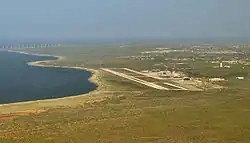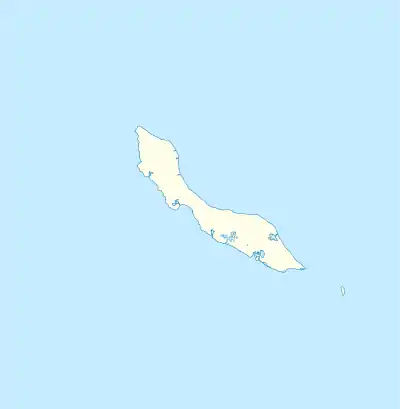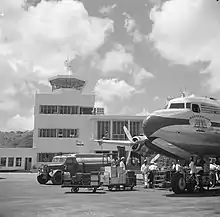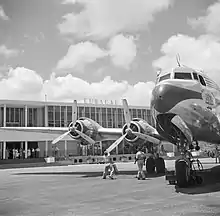Curaçao International Airport
Curaçao International Airport (IATA: CUR, ICAO: TNCC), (Papiamento: Aeropuerto Internashonal Hato, Dutch: Hato Internationale Luchthaven) also known as Hato International Airport (formerly Dr. Albert Plesman International Airport), is the only airport for the island of Curaçao.
Curaçao International Airport Hato International Airport Aeropuerto Internashonal Hato Hato Internationale Luchthaven | |||||||||||
|---|---|---|---|---|---|---|---|---|---|---|---|
 | |||||||||||
| Summary | |||||||||||
| Airport type | Public | ||||||||||
| Owner | Curaçao Airport Holding | ||||||||||
| Operator | Curaçao Airport Partners | ||||||||||
| Serves | Curaçao | ||||||||||
| Location | Willemstad, Curaçao | ||||||||||
| Hub for | |||||||||||
| Elevation AMSL | 29 ft / 9 m | ||||||||||
| Coordinates | 12°11′20″N 068°57′35″W | ||||||||||
| Website | curacao-airport.com | ||||||||||
| Map | |||||||||||
 CUR Location in Curaçao | |||||||||||
| Runways | |||||||||||
| |||||||||||
| Statistics (2021) | |||||||||||
| |||||||||||
Source: Curaçao Airport[1] | |||||||||||
The airport is located on the north coast of Curaçao, 12 kilometres (7.5 mi) from the capital Willemstad. Located on the Dutch Caribbean island of Curaçao, the airport connects the island to Europe, the Americas, and the Caribbean. It has the third longest commercial runway in the Caribbean region, accommodating up to a Boeing 747.
The airport serves as a main base for Divi Divi Air, JetAir Caribbean as well as EZAir. It formerly served as a main base for ALM, KLM, DCA, DAE and Insel Air.
In 2014, Curaçao International Airport opened a new General Aviation Center offering premier service in a separate building with a private entrance and exit and special amenities.
History


The airport was initially called Hato Airport, namesake to the nearby town of Hato. On Tuesday, 5 January 1954, the airport was renamed Dr. Albert Plesman airport. Plesman, director of the Royal Dutch Airlines for the Netherlands and Colonies, had died a few days earlier. Often it was spoken of Aeropuerto Plesman or Plesman Airport, unofficially also the name Hato remained in use till this day. Nowadays, the official name is Curaçao International Airport. It will be unnecessary to set out in detail, of which it is of paramount importance, that the Dutch aviation industry gets a firm footing in the vicinity of the Caribbean sea, where air traffic is now becoming more and more a factor of economic significance.' - Albert Plesman With the above argument, in March 1934, Albert Plesman, director of KLM, hoped to receive financial support from the Comité Vliegtocht Nederland-Indië. It was a new plan to head to the West. In the 1920s, it started to interest itself in the Caribbean region. Curaçao was developing itself in a beneficial way due to the presence of the oil refinery, and a growing number of people were starting to choose the region with the purpose of vacationing. Aviation companies were paying close attention to these developments and were researching if it was possible to create a connection between the United States, Curaçao and South America. The West Indische Gouvernement constructed a runway at the Hato plantation in Curaçao,
On 22 December 1934, the Snip plane arrived in Curaçao after an 8th day during a trip with the route Amsterdam-Marseille-Alicante-Casablanca-Porto Praia-Paramaribo-La Guaria-Curaçao.
Hato was one of the most important and busiest airports in the Caribbean during the Second World War. The airfield was used by the US Air Force for patrols against submarines.
During the 1960s, the 'Bestuurscollege' commissioned Netherlands Airport Consultants B.V. (NACO) to design a Master plan for the airport. This assignment was in connection with the expected arrival of the Boeing 747. The 'Jumbo' first flew on 9 February 1969.
Curaçao International Airport N.V. (Curinta) was founded in 1977 and operated the Airport until 2013. Its predecessor was the 'Luchthavenbedrijf', which was a department of the Government of Curaçao.
World War II
During World War II, the airport was used by the United States Army Air Forces Sixth Air Force conducting antisubmarine patrols. Flying units using the airfield were:
- 59th Bombardment Squadron (VI Bomber Command) 10 March 1942 – 13 July 1943 (A-20 Havoc)
- 32d Fighter Squadron (36th Fighter Group, Antilles Air Command, XXVI Fighter Command) 9 March 1943 – 13 March 1944, (P-40 Warhawk)
- Detachment operated from: Dakota Field, Aruba, 9 March 1943 – 9 March 1944
- Detachment operated from: Losey Army Airfield, Puerto Rico, 9 March – 4 June 1944
- 25th Bombardment Group (VI Bomber Command), 1 August – 5 October 1943
Airport Expansion Project
Curaçao Airport Partners (CAP) started off the expansion and visible enhancement of Curaçao International Airport as part of the Airport Expansion Project:
- 2014: Enhancement and expansion of the Check-In area and airport boulevard.
- 2016: Groundbreaking Ceremony of the Curaçao International Airport Terminal Expansion Project.
- 2016: Inauguration Arrivals Hall and inauguration of airport food&beverages services and stores. CAP now also provides a safer landside flow, as the 'road' right in front of the airport has been adjusted into a boulevard for pedestrians. Families, kids, airport employees and users can safely enjoy this area of the airport, while having a clear overview of the surroundings.
- Spantenbier Terminal Expansion on 1 June.
The Spantenbier and Terminal Expansion
The Terminal Expansion Project is a crucial component of the Airport Expansion Project. The SPANTENBIER of the expanded eastern part of the terminal marks yet another important milestone in the Airport Expansion Project. Important partner in this development is governmental company Curaçao Airport Holding, which is also investing significantly in the realization of the Terminal Expansion Project. Following this milestone, we will continue with the development of the terminal, which when inaugurated, will have doubled the Departure waiting area. In addition to a more spacious area for arriving, departing and transit passengers, Curaçao International Airport will gain an additional bridge that will be able to accommodate process and offer services to large wide-body aircraft. In addition, a second Mirador will be placed on the expanded part of the Terminal, ideal for enjoying plane spotting with family and friends or for photography.
Economic and social impact
CAP realizes the impact the airport developments have on Curaçao’s economy, and as the airport operator is committed to jointly offer an enhanced and improved facility and service, positioning Curaçao as a more competitive airport in the Caribbean region.
The start date of the complete construction work for the Terminal Expansion Project [terminal and continuation with the expansion of the middle part of the airport] was the second Quarter of 2016. The end date of the complete construction work (including new immigration Departures area) is set in December 2018. The start date of the terminal expansion/bridge construction work was June 2016. The end date is set for January 2018. When the Terminal area is operational, CAP and CAH will have offered more space (double the capacity) in the waiting area with facilities that enhance the comfort and experience of the traveler as well as more shopping and food & beverage facilities. CAP will also be able to offer a 6th bridge for major wide body airplanes. Here after CAP will continue with the expansion which includes separate routes for arriving or transit passengers and a new spacious area for Departing Area Immigration among others.
The aim is to be able to process 2.5 Million travelers.
Investment
Curaçao Airport Partners (private company) invested 25 million dollars in the Terminal Expansion. CAH also invested an additional 10 million dollars in the Terminal Expansion Project.
Airlines and destinations
Passenger
| Airlines | Destinations |
|---|---|
| Air Canada Rouge | Toronto–Pearson Seasonal: Montréal–Trudeau |
| Air Century | Punta Cana (begins 15 December 2023), Santo Domingo–La Isabela |
| Albatros Airlines | Las Piedras |
| American Airlines | Miami, Charlotte |
| Arajet | Santo Domingo–Las Américas |
| Avianca | Bogotá |
| Avior Airlines | Caracas[2] |
| Azul Brazilian Airlines | Belo Horizonte–Confins |
| Caribbean Airlines | Port of Spain |
| Copa Airlines | Panama City–Tocumen |
| Corendon Dutch Airlines | Amsterdam (begins 3 November 2023)[3] |
| Delta Air Lines | Atlanta (begins 16 December 2023)[4] |
| Divi Divi Air | Aruba, Bonaire |
| EZAir | Aruba, Barranquilla, Bonaire, Medellín |
| Jetair Caribbean | Aruba, Bonaire, Kingston, Medellín, Paramaribo,[5] Sint Maarten |
| JetBlue | New York–JFK |
| KLM | Amsterdam |
| LASER Airlines | Caracas[6] |
| Sky High | Santo Domingo–Las Americas |
| Surinam Airways | Paramaribo |
| TUI fly Netherlands | Amsterdam |
| United Airlines | Seasonal: Newark |
| WestJet | Seasonal: Toronto–Pearson |
| Winair | Aruba, Sint Maarten |
| Wingo | Bogotá |
Cargo
Statistics
| Year | 2022 | 2021 | 2020 | 2019 |
|---|---|---|---|---|
| Passengers handled[7] | 1,465,061 | 830,145 | 548,000 | 1,450,410 |
| Rank | Country | Passengers | % Total | % Change | Airlines |
|---|---|---|---|---|---|
| 1 | 177.042 | 41,0% | KLM, TUI fly Netherlands | ||
| 2 | 73.259 | 17,0% | American Airlines, JetBlue | ||
| 3 | 23.593 | 5,5% | Avianca, Copa Airlines | ||
| 4 | 21.169 | 4,9% | Air Canada, Sunwing Airlines, WestJet | ||
| 5 | 18.536 | 4,3% | Condor | ||
| 6 | 16.081 | 3,7% | Albatros Airlines, Avior Airlines, LASER Airlines | ||
| 7 | 14.060 | 3,3% | Aruba Airlines, Divi Divi Air, EZAir | ||
| 8 | 13.229 | 3,1% | Avianca, Wingo | ||
| 9 | 8.458 | 2,0% | Fly All Ways, Surinam Airways | ||
| 10 | 7.400 | 1,7% | TUI fly Belgium | ||
| Rank | Airline | Passenger share | Destinations |
|---|---|---|---|
| 1 | 29% | Amsterdam | |
| 2 | 19% | Amsterdam | |
| 3 | 13% | Charlotte, Miami | |
| 4 | 8% | Kralendijk, Oranjestad | |
| 5 | 6% | Barranquilla, Kralendijk, Medellín, Oranjestad | |
| 6 | 5% | Bogotá | |
| 7 | 5% | Kingston, Medellín, Philipsburg, Port-au-Prince, Santo Domingo | |
| 8 | 4% | Panama City | |
| 9 | 3% | New York | |
| 10 | 2% | Bogotá |
Coast Guard Air Station Hato
Located at the west side of Hato Airport there are hangars for the two Bombardier Dash 8 Maritime Patrol Aircraft and two AgustaWestland AW139 helicopters of the Dutch Caribbean Coast Guard. This was, until 2007, a naval airbase of the Royal Netherlands Navy which operated the base for 55 years. With a wide variety of aircraft in the past years Fireflies, Avengers, Trackers, Neptunes, Fokker F-27's, P-3C Orions, Fokker F-60's and several helicopters. After the political decision to sell all Orions the airbase wasn't needed anymore.
The west end of the airport is a USAF Forward Operating Base (FOB). The base hosts AWACS and transport aircraft. Until 1999 the USAF operated a small fleet of F-16 fighters from the FOB.
References
![]() This article incorporates public domain material from the Air Force Historical Research Agency.
This article incorporates public domain material from the Air Force Historical Research Agency.
- "Curaçao International Airport – Q4 and Year End Overview 2021". www.curacao-airport.com. Retrieved 20 May 2022.
- "Avior Airlines conectará a Venezuela con Curazao a partir del #4Oct: conozca el itinerario". Finanzasdigital.com (in Spanish). Retrieved 13 September 2023.
- "Bevestigd: Corendon in de winter met eigen A350 naar Curaçao" [Confirmed: Corendon in winter with own A350 to Curaçao]. Luchtvaartnieuws (in Dutch). 22 May 2023. Retrieved 22 May 2023.
- "Delta to resume nonstop service to Curaçao this winter". Delta Air Lines. Retrieved 14 July 2023.
- "Jetair Caribbean start vluchten tussen Curaçao en Paramaribo" [Jetair Caribbean begins flights between Curaçao and Paramaribo]. Luchtvaartnieuws (in Dutch). 26 January 2022. Retrieved 26 January 2022.
- "Laser Airlines to relaunch flights from Caracas to Curacao starting in May". Aviacionaldia.com (in Spanish). 13 April 2023. Retrieved 13 April 2023.
- "2022 – An Exceptional Year for Curaçao International Airport". Curaçao Airport. Retrieved 7 July 2023.
- "Airlines". Curaçao Airport. Retrieved 31 January 2023.
External links
 Media related to Hato International Airport at Wikimedia Commons
Media related to Hato International Airport at Wikimedia Commons- Airport information for TNCC at Great Circle Mapper. Source: DAFIF (effective October 2006).
- Accident history for CUR at Aviation Safety Network
.jpg.webp)